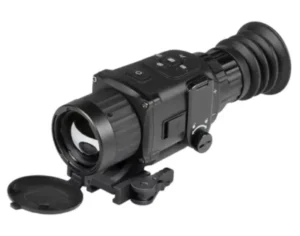The average distance a human eye can see clearly during the day is 3 miles. When darkness starts to fall, the distance you are able to see decreases. If its pitch dark outside, you can hardly see an inch ahead of you with your naked eyes only. This is where thermal optics and night vision devices come in to play. These advanced sighting tools improve our vision in the dark and help us see clearly.
In the beginning night vision and thermal optics were made for use by the military and law enforcement officers. In fact, the first night vision devices were manufactured for the soldiers during the world war. But these high-tech devices has greatly evolved and their ownership has significantly changed. With the advancements in technology, thermal and night vision devices have become a popular optic gear for civilian shooters especially hunters who like to extend their hunting trips after the sun has set.
Night Vision Vs Thermal Optics
Night vision and thermal optics are special type of devices that are used to provide better vision in the dark or low light settings. However, the two devices incorporate way different technology and the question that often arises is night vision vs thermal optics, which is better? In this post, we will compare and contrast night vision and thermal optics, discuss how they work and the applications that each device is best suited for. We will also highlight the capabilities and limitations of each so you have a clearer understanding of each.
Night Vision Devices

A night vision device works by amplifying the available light from the stars, moon and other celestial bodies to provide create a sight picture of the objects one is glassing. For a night vision optic to work, it must have an image intensifier tube whose main role is to amplify the small light particles collected. These tubes vary from one device to the other and are classified into three generations: Gen 1, 2 and 3.
Gen 1
Gen 1 Night Vision Devices are the oldest of the three. This night vision generation dates way back in the 1960’s when it was first made. Devices that use Gen 1 night vision technology have a maximum useful range of about 75 yards depending on the ambient lighting conditions. They are more affordable than the other generations and ideal for the budget buyers.
However, Gen1 night vision devices have two main drawbacks. Firstly, the images generates is are poor in terms of resolution and quality. They are also more susceptible to blooming, a condition where excessive light distorts the image views.
Gen 2
A Gen 2 night vision device is a step up from Gen 1 counterparts. Devices that use this night vision generation tend to have a comparatively longer detection range of about 200 yards in the typical night time environment. Besides, the sight pictures produced have better resolution and clarity even in the pitch-dark night settings.
Another advantage that Gen 2 devices have over Gen 1 is longer battery life and a less susceptibility to blooming. However, Gen 2 devices have the drawback of being more expensive.
Gen 3
Generation 3 is the latest generation and the best of the three. It is what the US military and special forces use for military applications. All Gen 3 grades/levels are outstanding in terms of resolution and have a longer detection range than the Gen 2 counterparts. Furthermore, the life expectancy of Gen 3 night vision devices is extremely long and the durability and reliability is unparalleled.
But Gen 3 night vision devices are hard to find as those made are mostly preserved for the military. They also cost a fortune whereby one pays thousands of dollars for a single product.
How Night Vision Devices Work?
Night vision devices operate by using the same technology that standard cameras use but with greater magnification. During use, the night vision device absorbs any visible light available. The light collected is then amplified electrically, taken through a series of processes after which the image of the object being views is formed with a greenish color.
Areas Where Night Vision Devices are Used
Other than the military, patrols and law enforcement, night vision devices including rifle scopes, monocular and goggles are widely used for:
- Hunting in the dark
- Home defense
- Surveillance
- Wildlife monitoring
Pros of Night Vision Devices
- Versatility
- Ability to adapt into different lighting and weather conditions
- Longer detection range for the models with latest night vision technology
Cons of Night Vision Devices
- Dependent on ambient light form the moon, stars and distant light sources
- Pricey
Read Also
- Best Night Vision Scopes for AR-15
- Best Thermal Rifle Scope for Hog Hunting
- 7 Best Thermal Scopes for AR-15
- 6 Best Night Vision Scopes for Hog Hunting
Thermal Optics

Thermal optics, unlike night vision devices use infrared imaging to measure the heat signatures an object emits and then translates those heat signatures into an image. Since thermal optics don’t dependent on light to operate, they work in all weather and lighting conditions, even in pitch-dark moonless nights.
With a thermal optic, the brightness and clarity of the images generated is dependent on how much infrared heat signatures an object emits. The higher the signatures, the brighter the images will be. Besides, thermal optics have an added benefit of being functional in obstacles like smoke, fog, dust, sand and mist.
How Thermal Optics Work?
A thermal optic device works by detecting temperatures from an object. Every object on earth emits infrared light which is invisible to the eye but detectable by a thermal imaging device if its heat intensity is high enough.
After the infrared heat is detected, the thermal device in use will create an image of the object that emits the heat in a process called thermal imaging. If there are multiple objects being observed, the object with the highest thermal radiation will appear brighter than the rest.
Areas Where Thermal Optics are Used
Since thermal optics don’t depend on light to operate, they are ideal for a wide range of applications that include:
- Law enforcement
- Search and rescue
- Hunting
- Fire fighting
- Research and development
- Science and many more
Pros of Thermal Optics
- Not light dependent. A thermal optic will work effectively in any lighting condition as it is not dependent on light.
- Versatile. Thermal optics are unbeatable when it comes to versatility
- Ideal for use in any weather condition and different obstacles such as fog, smoke and mist
- Long lifespan. The lifespan of thermal imaging devices is long to ensure that the buyer gets the most value for their money
- High detection range in all environments, during the day and at night as well
Cons of Thermal Optics
- High cost. When comparing night vision vs thermal optics, the latter are more expensive. The high cost is attributed to the advanced technology these devices are made with.
Night Vision Vs Thermal Optics: Which is Superior?
As you can see, night vision and thermal imaging devices have the applications each is best suited for, pros and cons. According to us, thermal optics are by far more superior. Although these devices are the most expensive of the two, they are more versatile considering that they don’t dependent on light to operate. Besides, all thermal optics work well under most obstacles where a night vision device would be impractical to use.
However, the final decision is largely a matter of personal preference. So, weigh in the benefits that come with each device then pick the one that is best for your individual needs.

